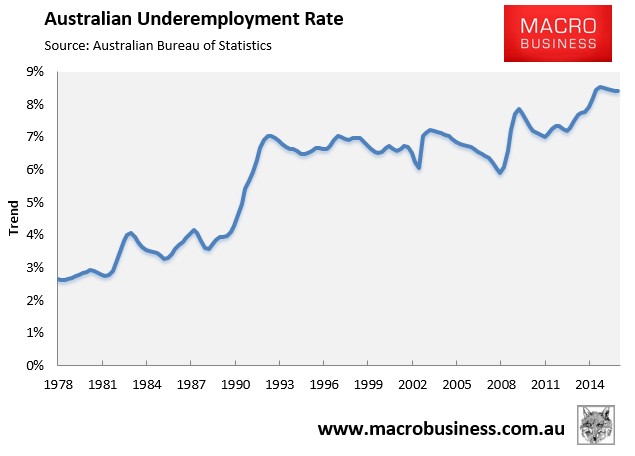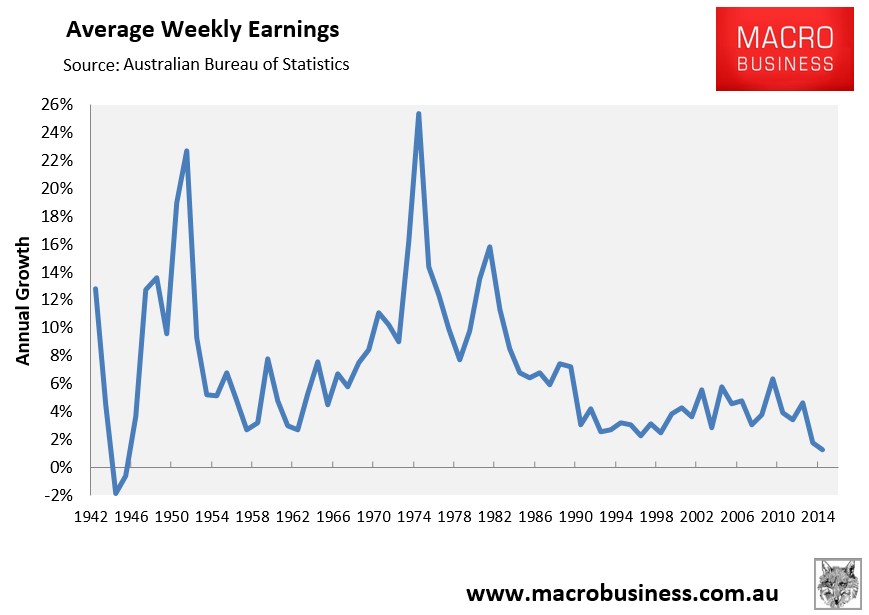On Monday night, ABC Four Corners ran a ripper report entitled “Future Proof”, which examines the future of work in Australia and whether we are preparing our children properly for the future.
The report features a bunch of experts and commentators, some of who believe that up to 40% of current jobs (5 million) could disappear within 15 years as technological change takes hold, although many of these will be replaced by new jobs in areas that we probably haven’t even thought of.
Below are some key extracts from the transcript, beginning with the pessimistic news:
GEOFF THOMPSON: Today almost 12 million of us have a job, but Australia’s Committee for Economic Development predicts that technological change could eliminate five million jobs within the next 15 years. Stephen Martin is CEDA’s chief executive.
STEPHEN MARTIN CHIEF EXECUTIVE, CEDA: What we did was apply an analysis to with all things being equal what will be the likelihood of jobs disappearing in Australia over the next 10 years, and what we found is something like 40 per cent of current jobs as they are structured at the moment is likely, are likely to disappear, but that in regional areas that could be as high as 60 per cent.
GEOFF THOMPSON: Machines have been replacing human workers since the industrial revolution. Since then any routine, repeatable task has been an endangered job. Now automation has broken free of the factory to overtake more complex arenas of human labour. Last year, the introduction of robots at Sydney’s Port Botany cut the number of dock workers in half…
GEOFF THOMPSON: Bank tellers, supermarket check-out staff and airline check-in staff have already been pushed aside by technology. The next wave of automation will be driven by cognitive computers, which learn to solve complex problems by themselves…
Jon Williams is a managing partner with the global consulting giant PwC, which predicts that 44 per cent of current Australian jobs are at risk over the next 20 years.
JON WILLIAMS: So many of today’s jobs will disappear. So there’ll be fewer of today’s jobs, but we believe that there’ll be more of tomorrow’s jobs to replace them. Really what what’s happening is the same thing that happened to blue collar work in the Seventies and Eighties and Nineties is gonna happen to white collar work in the next ten to fifteen years…
GEOFF THOMPSON: The jobs most vulnerable to computerisation include accountants, lawyers and real estate agents. Demand for beauticians, personal trainers, manicurists and intensive care nurses has been booming. The number of baristas in Australia tripled between 2006 and 2011…
CHARLES BRASS, THE FUTURES FOUNDATION: There are all sorts of jobs today I couldn’t have conceived of 40 years ago and in 40 years time there’ll be all sorts of jobs that I can’t conceive of today, that is true. The question though is what sorts of jobs will they be, how many people will have access to them and how will those people be able to survive in the world through the jobs that they’re doing?..
TONY NICHOLSON, BROTHERHOOD OF ST LAURENCE: In years gone by, we have expected young people just to be able to leave school and walk into a job and then find their way in a career path, in this modern economy, ah that’s not the case. So it’s an important point that the transition from school to work has become much more problematic for young people than it has been in decades gone by. In the decade ahead, we’ve got to give much more public policy attention to the issue of ah assisting those young people make the transition successfully.
CHARLES BRASS, THE FUTURES FOUNDATION: We are already at the point where there are not enough jobs for everybody who wants them in Australia. There are, quite apart from the 5.8 per cent who are unemployed, there are a significant number of others who have just given up trying to find a job, they’re discouraged. So we’re already at the state where we haven’t got enough jobs and it seems that it’s increasing.
GEOFF THOMPSON: Futurist Charles Brass argues that if machines keep learning to do our work more cheaply than we can it’s inevitable that there won’t be enough work to go round.
CHARLES BRASS:… I know there are people who say don’t worry about it, the jobs will come, but the debate is done. The evidence is in. What jobs are being created are part time, casual and fragile. There’s not enough money in those jobs to sustain people and there aren’t enough of those jobs for all the people that are falling out the bottom…
GEOFF THOMPSON: A university degree was once seen as a sure pathway to a secure career, but not any more. The full-time employment rate for new graduates is now under 70 per cent, the lowest rate in more than 30 years. Some graduates like Brett Edman have to settle for low-skilled jobs outside the profession they trained for…
The latest unemployment figures confirm a trend that’s been growing for decades. Two-thirds of all new jobs created in the past three years have been part-time. Since 1980 the proportion of part-time jobs has doubled from one in six to almost one in three.
JIM STANFORD, CENTRE FOR FUTURE WORK, AUSTRALIA INSTITUTE: There’s no doubt from the hard numbers that the average quality and security of work in Australia has deteriorated ah over the last few years. Ah we see the growth of ah what you might call precarious work in all kinds of forms. Ah part-time work, temporary work, ah casualisation, what that means is ah not for all Australians but for more of them ah work is eh increasingly insecure, they don’t know when they’re gonna be working, they don’t know if they’ll have enough work, and the average pay and compensation ah of work has declined. So the overall trend is definitely negative…
Others, like KPMG’s Bernard Salt, see less of a problem:
BERNARD SALT, KPMG: Jobs of the past have been replaced by jobs of today, jobs for today will be replaced by jobs of the future…
We have had digital disruption, ah, in social media, in the media, in the taxi industry, we’ve had the globalisation of manufacturing, particularly impacting Australia and yet the evidence is there’s still more people in work. From the year 2000 to 2016 the number of workers in the Australian workforce has increased by three million. The number of people who are unemployed comparing 2000 with 2016 has virtually not changed, so about 6 per cent compared to 5.7 per cent. So the number of workers has increased, the nature of work may well be changed but the kind of work, ah, has, ah, has simply shifted, the middle class is doing other jobs…
There are other jobs that are expanding and these would be jobs in personal services for example or in technology, or in healthcare or in aged care, childcare for example. The nature of work is changing, some jobs are diminishing, other jobs are evolving…
To say that, um, employment should be fulltime I think is quite prescriptive and quite wrong, it simply does not reflect the realities of modern Australia. Ah, th- the fact of the matter is that a lot of female workers, not all, ah, by any means, but a substantial proportion of the female workforce do not want fulltime work. It’s not being imposed by someone from beyond, this is what people actually want from the bottom up.
Personally, I don’t agree with Salt’s benign view. If people were happy with part-time employment, then the underemployment rate would not be tracking near an all-time high:

And I doubt they would be happy with growth in average weekly earnings near an all-time low:

As for the solutions, commentators believe that Australia needs to increase investment in education, especially in technology-related STEM fields:
JON WILLIAMS PwC: So we need more people with those pure hard skills in science technology engineering and and maths. The second revolution is in learning how to to learn, learning how to build, learning how to design um because that can be applied throughout someone’s life to solve all sorts of problems as technology change changes.
JAN OWEN CEO, FOUNDATION FOR YOUNG AUSTRALIANS: STEM is going to be part of the future, it’s not the only part of the future. Fifteen-year-olds in Australia today have got um not the levels of digital proficiency, financial literacy, um and then also ability to communicate, present you know, what we call enterprising skills or transferrable skills. If they don’t have those skills, they’re going to find it really hard to navigate a very flexible career that has a whole heap of casual and other work going on in it.
GEOFF THOMPSON: ASMS tries to prepare students for the changing world of work with what it calls challenge-based learning. Traditional subjects like English are not taught on their own. Instead they are mixed together to solve real-life problems. Every class is a collaboration.
GLENYS THOMPSON DEPUTY PRINCIPAL, ASMS: People are going to need to be fabulous communicators. They’re going to be, need to be really great team players. Not only that, they need to have some discipline and knowledge but they need to know how to learn because we don’t know what it is they’re going to need to learn. So when we work with the students we work really closely not only on them gaining the academic knowledge but also on gaining those dispositions and capabilities that are going to set them up to be successful in the future because without that, the students won’t have choices…
JAN OWEN CEO, FOUNDATION FOR YOUNG AUSTRALIANS: We could start working with 12 year olds today, by the time they’ve done six years of high school and they’re 18, we could genuinely have changed their trajectory if we focussed on some of these education changes that need to happen and we could genuinely set them up and then therefore Australia up for a very different future.
The report is well worth a watch if you have the time.

